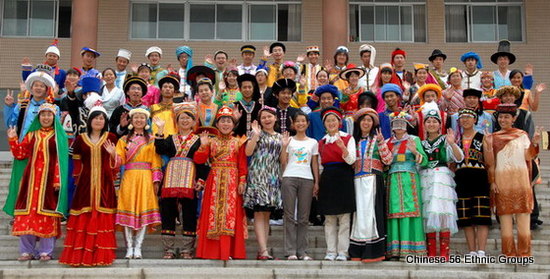China is a united multi-ethnic nation of 56 ethnic groups. According to the fourth national census, taken in 1990, the Han people made up 91.96 percent of the country’s total population, and the other 55 ethnic groups, 8.04 percent. As the majority of the population is of the Han ethnic group, Chinas other ethnic groups are customarily referred to as the national minorities.
The Han people can be found throughout the country, though mainly on the middle and lower reaches of the Yellow River, the Yangtze River and the Pearl River valleys, and the Northeast Plain. The national minorities, though fewer in number, are also scattered over a vast area (see the attached table, and can be found in approximately 64.3 percent of China, mainly distributed in the border regions from northeast China to north, northwest and southwest China. Yunnan Province, home to more than 20 ethnic groups, has the greatest diversity of minority peoples in China. In most of Chinas cities and county towns, two or more ethnic groups live together. Taking shape over Chinas long history, this circumstance of different ethnic groups living together in one area while still living in individual compact communities in special areas continues to provide the practical basis for political, economic and cultural intercourse between the Han and the various minority peoples, and for the functioning of the autonomous national minority areas system.

Among those 56 ethnic groups, ten of them believe in Islam.
| Ethnic Group Name | Population (100,000) | Major Areas of Distribution |
|
Hui
|
86.120
|
Ninxia, Gansu, Henan, Hebei, Qinghai, Shandong, Yunnan, Xinjiang, Anhui, Liaoning, Heilongjiang, Jilin, Shaanxi, Beijing, Tianjin
|
|
Uygur
|
72.070
|
Xinjiang
|
|
Kazak
|
11.108
|
Xinjiang, Gansu, Qinghai
|
|
Dongxiang
|
3.737
|
Gansu, Xinjiang
|
|
Kirgiz
|
1.435
|
Xinjiang, Heilongjiang
|
|
Salar
|
0.875
|
Qinghai, Gansu
|
|
Tajik
|
0.332
|
Xinjiang
|
|
Ozbek
|
0.148
|
Xinjiang
|
|
Bonan
|
0.117
|
Gansu
|
|
Tatar
|
0.051
|
Xinjiang
|




 Ethnic Groups in China
Ethnic Groups in China